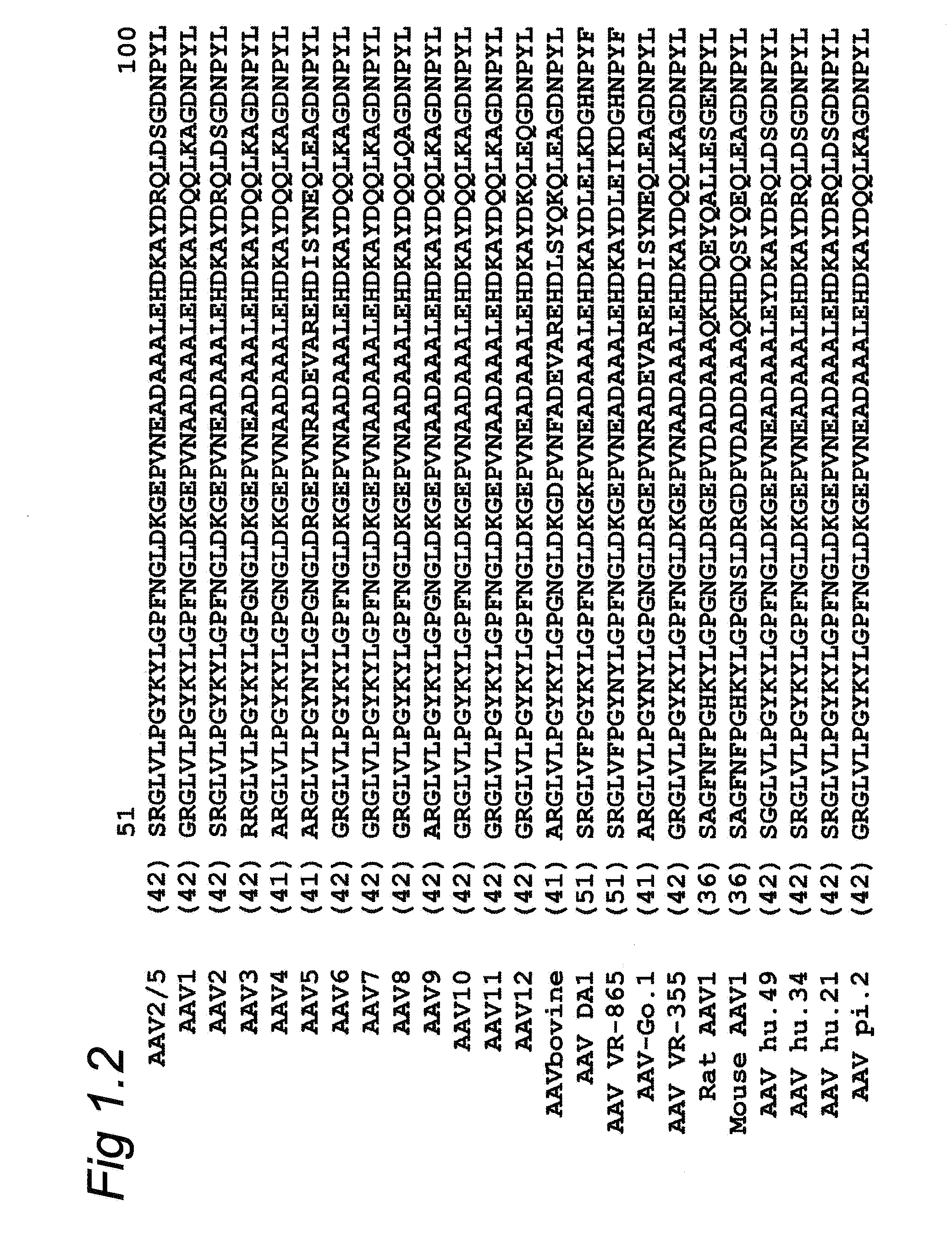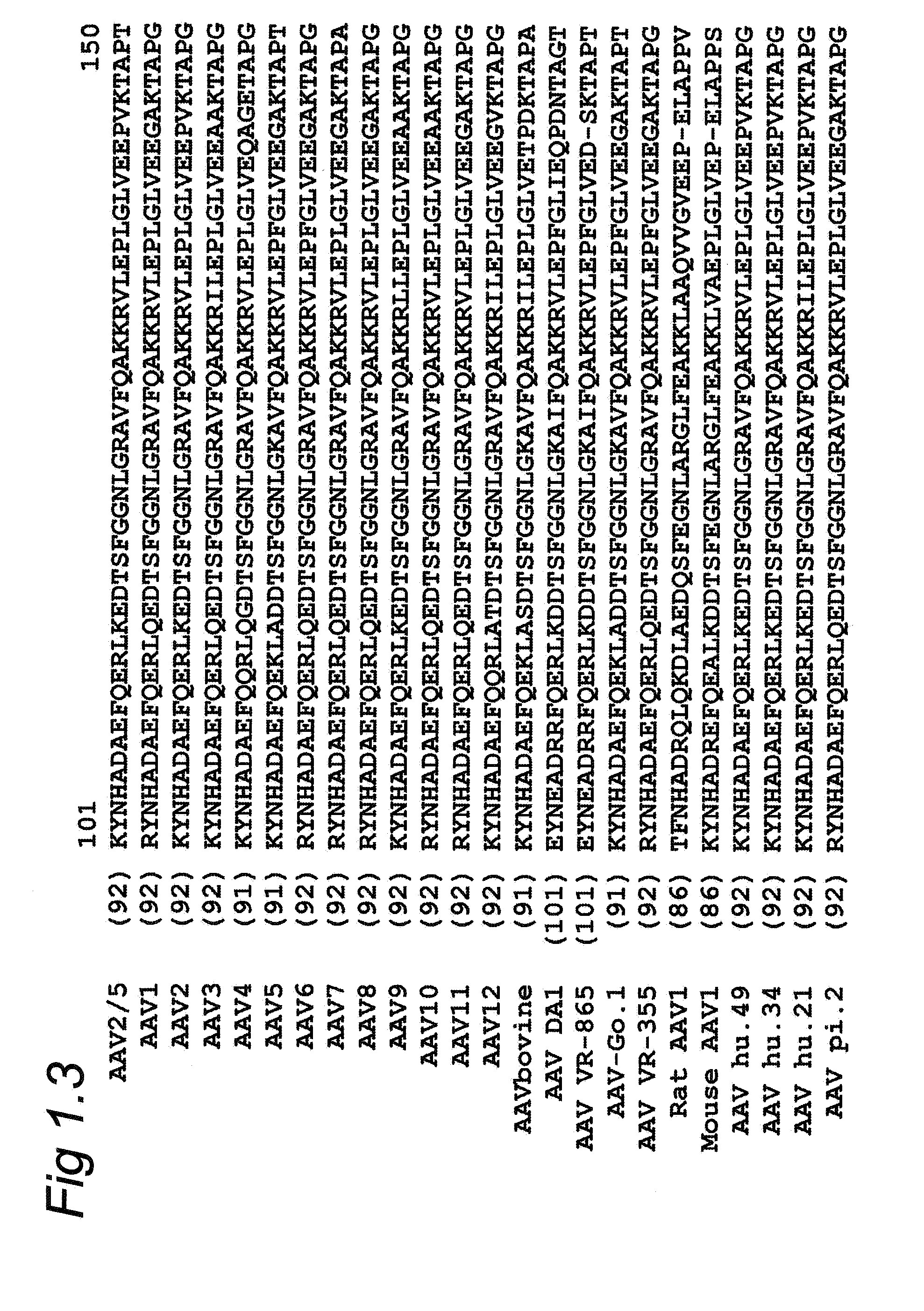Parvoviral capsid with incorporated gly-ala repeat region
a capsid protein and repeat region technology, applied in the field of parvovirus vector production, can solve the problem of inability to insert a long gar region in the capsid protein, and achieve the effect of reducing the number of capsid proteins and reducing the number of viral replications
- Summary
- Abstract
- Description
- Claims
- Application Information
AI Technical Summary
Benefits of technology
Problems solved by technology
Method used
Image
Examples
example 1
Vector Construction
1.1 Site Directed Mutagenesis PCR
[0074]To introduce the GAr sequence into the Cap2 / 5 gene a site directed mutagenesis approach was used. To create a specific mutation in the capsid gene, the Stratagene QuikChange® XL kit was utilized. This kit can introduce mutations at a specific location when sense and anti-sense primers that contain the GAr sequence are used in a PCR reaction. Primers that insert a GAr sequence into the Cap2 / 5 gene were designed for 13 different sites in the VP3 protein. These sites have been previously described in literature, were it was shown that insertions at these sites could produce infective AAV particles. Most of these sites are located in AAV2 / 5 hypervariable regions. Hypervariable regions are stretches of the Cap protein that have the least evolutionary pressure on their protein sequence. Amino acid differences between AAV serotypes are at their highest in these protein stretches. It is hypothesized that AAV would be better able to t...
example 2
AAV Production and Purification
[0088]To produce AAV2 / 5GAr, 2.0.106 log phase SF+ cells / ml were infected with baculovirus originating from constructs pVD88 (Rep), Cap2 / 5GAr and pVD129 or pVD43 (hAAT-Apoa1 or CMV-LPL as a transgene). Bac.VD88 (Rep) was added in a 1:20 ratio whereas the transgene and Cap2 / 5GAr baculoviruses were both added in a 1:100 ratio. Infected cells were cultured in SF900II medium (Gibco) without FBS for 3 days at 28° C. AAV2 / 5GAr viral cultures were lysed by adding 10% of 10× Lysisbuffer (1.5M Nacl, 0.5M Tris-Hcl, 1 mM MgCl2, 1% Triton x-100, pH=8.5) to the culture and incubating for 1 hour at 28° C. in a shaker incubator. Genomic DNA was digested by adding 4 μl / 100 ml Benzonase (Merck) and incubating at 37° C. for 1 hour. Virus was harvested by centrifugation (15′ at 1900×g). Supernatant containing virus was stored at 4° C. Prior to loading crude lysate onto the affinity column it is filtered on a 0.45 μm Millipak filter (Millipore). Viral titers were determine...
example 3
Infectivity of the rAAV-GAr Vector In Vivo
[0105]First, the in vivo infection efficiency of cells by the rAAV-GAr vectors was tested. The rAAV2 / 5-GAr vectors containing eGFP (enhanced Green Fluorescent Protein) expression cassette were injected intravenously into C57 / b16 or BALB / c mice and the transgene expression was measured. Approximately 6×1012 genomic copies of rAAV-GAr are injected per kg mouse. The eGFP expression was analyzed by microscopic analysis and / or immunohistochemistry of the major organs focussing on the liver and spleen.
[0106]Tissue processing was carried out as follows. For fluorescent microscopy, the tissues or fractions of tissue were fixed by immersion with 4% formaldehyde / 7% picric acid / 10% sucrose in PBS, rinsed quickly with PBS, frozen in liquid nitrogen and stored in −80° C. until cryosectioning. For immunohistochemistry fractions of liver, spleen and thymus were frozen in liquid nitrogen immediately after preparation and stored in −80° C. until cryosectioni...
PUM
| Property | Measurement | Unit |
|---|---|---|
| Volume | aaaaa | aaaaa |
| Immunogenicity | aaaaa | aaaaa |
Abstract
Description
Claims
Application Information
 Login to View More
Login to View More - R&D
- Intellectual Property
- Life Sciences
- Materials
- Tech Scout
- Unparalleled Data Quality
- Higher Quality Content
- 60% Fewer Hallucinations
Browse by: Latest US Patents, China's latest patents, Technical Efficacy Thesaurus, Application Domain, Technology Topic, Popular Technical Reports.
© 2025 PatSnap. All rights reserved.Legal|Privacy policy|Modern Slavery Act Transparency Statement|Sitemap|About US| Contact US: help@patsnap.com



